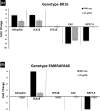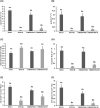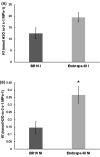Remodeling of the cell wall as a drought-tolerance mechanism of a soybean genotype revealed by global gene expression analysis
- PMID: 36304479
- PMCID: PMC9590462
- DOI: 10.1007/s42994-021-00043-4
Remodeling of the cell wall as a drought-tolerance mechanism of a soybean genotype revealed by global gene expression analysis
Abstract
Drought stress is major abiotic stress that affects soybean production. Therefore, it is widely desirable that soybean becomes more tolerant to stress. To provide insights into regulatory mechanisms of the stress response, we compared the global gene expression profiles from leaves of two soybean genotypes that display different responses to water-deficit (BR 16 and Embrapa 48, drought-sensitive and drought-tolerant, respectively). After the RNA-seq analysis, a total of 5335 down-regulated and 3170 up-regulated genes were identified in the BR16. On the other hand, the number of genes differentially expressed was markedly lower in the Embrapa 48, 355 up-regulated and 471 down-regulated genes. However, induction and expression of protein kinases and transcription factors indicated signaling cascades involved in the drought tolerance. Overall, the results suggest that the metabolism of pectin is differently modulated in response to drought stress and may play a role in the soybean defense mechanism against drought. This occurs via an increase of the cell wall plasticity and crosslink, which contributed to a higher hydraulic conductance (K f) and relative water content (RWC%). The drought-tolerance mechanism of the Embrapa 48 genotype involves remodeling of the cell wall and increase of the hydraulic conductance to the maintenance of cell turgor and metabolic processes, resulting in the highest leaf RWC, photosynthetic rate (A), transpiration (E) and carboxylation (A/C i). Thus, we concluded that the cell wall adjustment under drought is important for a more efficient water use which promoted a more active photosynthetic metabolism, maintaining higher plant growth under drought stress.
Supplementary information: The online version contains supplementary material available at 10.1007/s42994-021-00043-4.
Keywords: Gene expression; Molecular physiology; RNA-seq; Water-use efficiency.
© Agricultural Information Institute, Chinese Academy of Agricultural Sciences 2021.
Conflict of interest statement
Conflict of interestOn behalf of all authors, the corresponding author states that there is no conflict of interest.
Figures








References
-
- Aimar D, Calafat M, Andrade AM, Carassay L, Abdala GI, Molas ML (2011) Drought tolerance and stress hormones: from model organisms to forage crops. Intech: from model organisms to forage crops
-
- Anbazhagan K, Bhatnagar-Mathur P, Vadez V, Dumbala SR, Kishor PB, Sharma KK. Dreb1a overexpression in transgenic chickpea alters key traits influencing plant water budget across water regimes. Plant Cell Rep. 2015;34:199–210. - PubMed
-
- Anders S, Huber W (2012) Differential expression of RNA-Seq data at the gene level–the DESeq package. Heidelberg, Germany: European Molecular Biology Laboratory (EMBL)
LinkOut - more resources
Full Text Sources
